在MIX 09上,Nikhil Kothari發布了微軟的一神作——Microsoft .NET RIA Services。雖然目前的版本僅僅是可憐的"March '09 Preview”,但它已經足夠讓人興奮不已。簡單地說,在這之前,如果你用到了現在的RIA技術比如Silverlight,你只能選擇寫大量的服務或者WCF來實現數據的操作功能;而有了.NET RIA Services,你在RIA項目上操作數據,就像ASP.NET那樣方便!
Nikhil Kothari在MIX09上介紹.NET RIA Services的視頻:
http://www.nikhilk.net/RIA-Services-MIX09.aspx
Microsoft .NET RIA Services March '09 Preview及文檔下載地址:
http://www.microsoft.com/downloads/details.aspx?displaylang=en&FamilyID=76bb3a07-3846-4564-b0c3-27972bcaabce
MSDN Code Gallery中的.NET RIA Services Samples
http://code.msdn.microsoft.com/RiaServices
好了,以上是概要,下面讓我們說得更詳細些。
傳統的RIA是怎樣操作數據的
在去年這個時候,Silverlight 2Beta剛發布,有個朋友問我能不能使用Silverlight直接操作數據庫。當時的答案當然是:很遺憾,不行。我們不得不使用大量的Web Services或者WCF來提供對數據庫操作的每一個環節,Silverlight只能與數據層“間接接觸”。
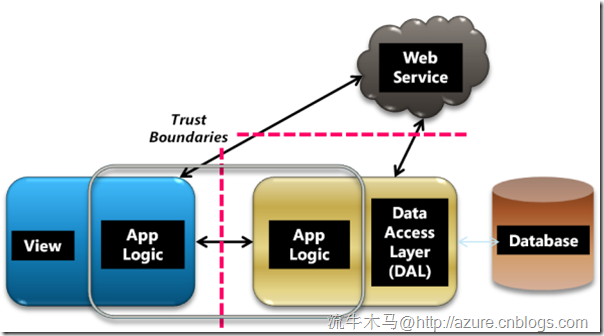
上圖表明了整個過程。這樣的數據操作雖然已經被大家習慣,但它是不合理的。就像是在實現“三通”以前,咱們去台灣只能先去香港轉機。
博客園的大牛Shareach前幾天寫了一個Silverlight的聊天程序,數據操作使用的是WCF Duplex Service實現雙向通訊,非常牛,大家可以去看看。(圍觀連接:http://www.cnblogs.com/yinpengxiang/archive/2009/03/23/slChat.html)這是Silverlight操作數據層的一個成功案例,但也會讓人覺得悲哀:這樣一個表面上很簡單的聊天程序,為什麼有了WCF的參與就變得很復雜?
這是因為,這樣的“間接接觸”,不僅不直觀,還浪費了開發者大量的經理去考慮一些不該考慮的問題。開發者需要在客戶端、Web Service端,BLL端各寫一個不同版本的數據操作代碼,並且還要考慮他們之間交互的安全性、網絡情況等等,簡直就是一個浪費大量ATP只產生微量GDP的過程。
合理的數據操作應該怎樣的
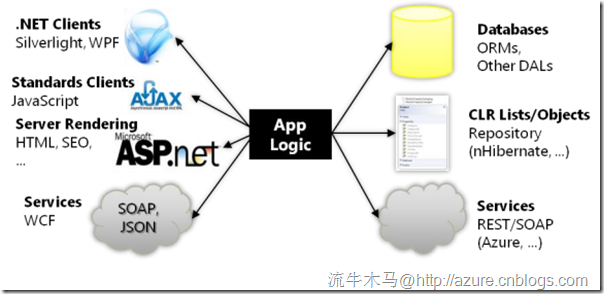
上圖展示了微軟在RIA與數據庫交互上的宏偉構想:無論是Silverlight,WPF,Javascript,還是ASP.NET,WCF,它們都應該使用無差別的數據邏輯,能夠直接訪問到數據層面,而不需要通過一層類似“代理”的數據服務。
Microsoft .NET RIA Services將如何實現“合理”
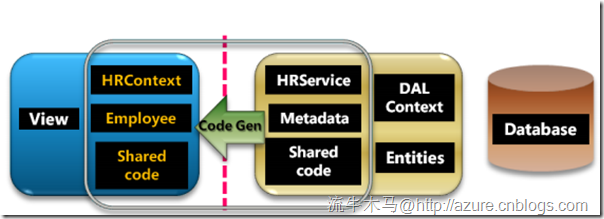
以上就是.NET RIA Services的實現原理。開發者在ASP.NET端的數據處理類(本圖中是HRService)繼承自一個叫做DomainService的類,在裡面實現一些數據操作。.NET RIA Services就會自動生成相應的客戶端類(本圖中是HRContext)。而在我們開發客戶端的時候,我們就可以直接調用.NET RIA Services生成的那個類,直接操作數據層面。
入門實例:
在了解.NET RIA Services想要完成的任務及其具體實現方法後,我們可以開始通過實例的方式來體驗一下了。
開發環境:Visual Studio 2008 SP1 ,Silverlight 3 Beta SDK ![]() ,Silverlight Tools 3.0
,Silverlight Tools 3.0![]() , Microsoft .NET RIA Services March '09 Preview
, Microsoft .NET RIA Services March '09 Preview![]() , SQL Server 2005
, SQL Server 2005
在VS2008中新建Silverlight項目
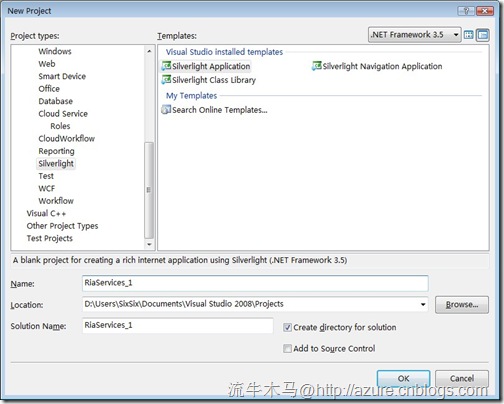
將Silverlight連接到ASP.NET Server project上。
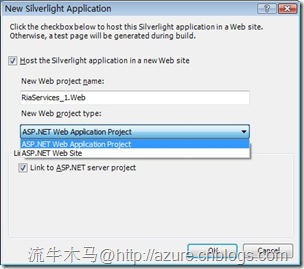
完成該步驟後的Solution Explorer如下圖所示
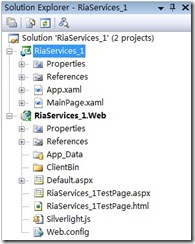
在Web項目上單擊右鍵,新建![]()
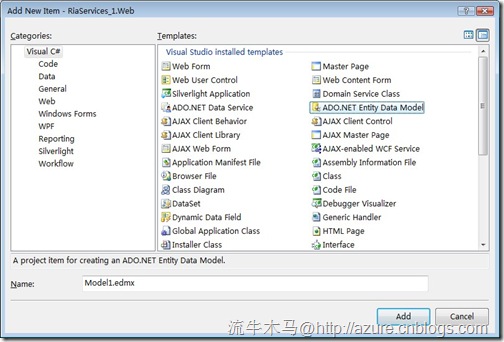
選擇SQL Server2005裡的數據庫和表。VS會幫我們生成一個ADO.NET的實體(Entity)。
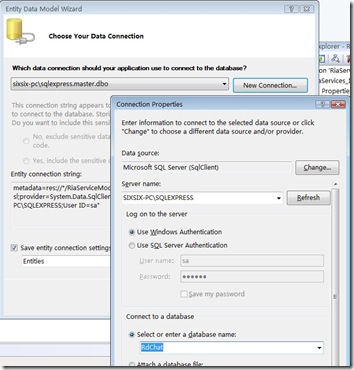
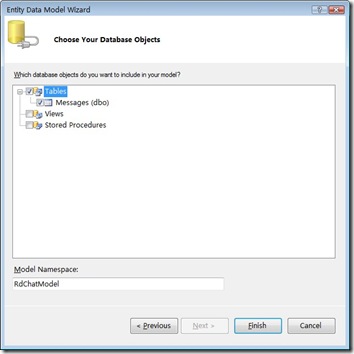
生成的文件後綴名為.edmx,如本例中的![]()
編譯整個Solution。
再次在Web項目上右擊,新增本文的主角——Domain Service Class![]() 。"Domain Service Class”這名字挺熟的吧?嗯,上文介紹過了。
。"Domain Service Class”這名字挺熟的吧?嗯,上文介紹過了。
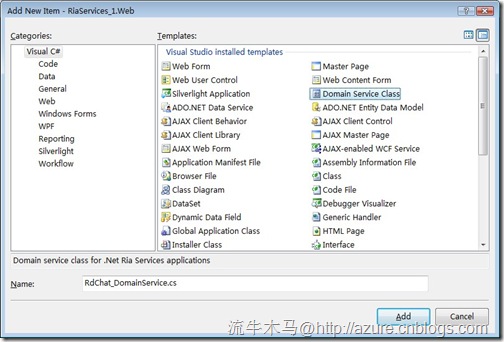
根據提示勾選需要的部分。在本例中,我們選擇了Messages表作為實體,並選擇”Enable editing”,這樣在生成的類中會初始包括Get,Insert,Update,Delete 4個基本的實體操作方法
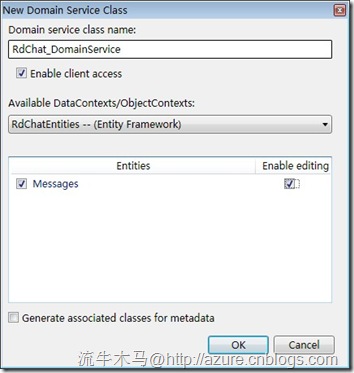
完成上面的操作後,會在Web項目下生成RdChat_DomainService.cs類。
namespace RiaServices_1.Web
{
using System;
using System.Collections.Generic;
using System.ComponentModel;
using System.ComponentModel.DataAnnotations;
using System.Linq;
using System.Web.Ria;
using System.Web.Ria.Data;
using System.Web.DomainServices;
using System.Data;
using System.Web.DomainServices.LinqToEntities;
// Implements application logic using the RdChatEntities context.
// TODO: Add your application logic to these methods or in additional methods.
[EnableClientAccess()]
public class RdChat_DomainService : LinqToEntitiesDomainService<RdChatEntities>
{
// TODO: Consider
// 1. Adding parameters to this method and constraining returned results, and/or
// 2. Adding query methods taking different parameters.
public IQueryable<Messages> GetMessages()
{
return this.Context.Messages;
}
public void InsertMessages(Messages messages)
{
this.Context.AddToMessages(messages);
}
public void UpdateMessages(Messages currentMessages, Messages originalMessages)
{
this.Context.AttachAsModified(currentMessages, originalMessages);
}
public void DeleteMessages(Messages messages)
{
if ((messages.EntityState == EntityState.Detached))
{
this.Context.Attach(messages);
}
this.Context.DeleteObject(messages);
}
}
}
再次編譯整個Solution。
點擊Show All Files,你會發現系統已經為你生成了客戶端的類,放在了Generated_Code目錄下。我們將它include進來。
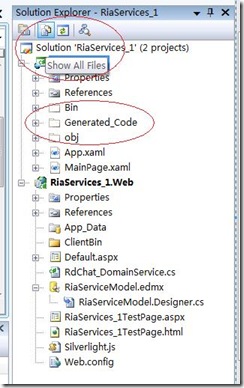
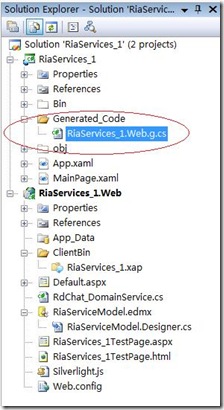
這個RiaServices_1.Web.g.cs,是服務端RdChat_DomainService.cs的對應客戶端版本。它包含了所有服務端版本類中定義的方法、實體等,而可在客戶端直接調用。它打代碼如下:
//------------------------------------------------------------------------------
// <auto-generated>
// This code was generated by a tool.
// Runtime Version:2.0.50727.3053
//
// Changes to this file may cause incorrect behavior and will be lost if
// the code is regenerated.
// </auto-generated>
//------------------------------------------------------------------------------
namespace RiaServices_1.Web
{
using System;
using System.Collections.Generic;
using System.ComponentModel;
using System.ComponentModel.DataAnnotations;
using System.Linq;
using System.Runtime.Serialization;
using System.Web.Ria.Data;
using System.Windows.Ria.Data;
[DataContract(Namespace="http://schemas.datacontract.org/2004/07/RiaServices_1.Web")]
public sealed partial class Messages : Entity
{
private string _body;
private string _name;
private string _partitionKey;
private string _rowKey;
private Nullable<DateTime> _timestamp;
[DataMember()]
public string Body
{
get
{
return this._body;
}
set
{
if ((this._body != value))
{
this.ValidateProperty("Body", value);
this.RaiseDataMemberChanging("Body");
this._body = value;
this.RaiseDataMemberChanged("Body");
}
}
}
[DataMember()]
public string Name
{
get
{
return this._name;
}
set
{
if ((this._name != value))
{
this.ValidateProperty("Name", value);
this.RaiseDataMemberChanging("Name");
this._name = value;
this.RaiseDataMemberChanged("Name");
}
}
}
[DataMember()]
[Key()]
public string PartitionKey
{
get
{
return this._partitionKey;
}
set
{
if ((this._partitionKey != value))
{
this.ValidateProperty("PartitionKey", value);
this.RaiseDataMemberChanging("PartitionKey");
this._partitionKey = value;
this.RaiseDataMemberChanged("PartitionKey");
}
}
}
[DataMember()]
[Key()]
public string RowKey
{
get
{
return this._rowKey;
}
set
{
if ((this._rowKey != value))
{
this.ValidateProperty("RowKey", value);
this.RaiseDataMemberChanging("RowKey");
this._rowKey = value;
this.RaiseDataMemberChanged("RowKey");
}
}
}
[DataMember()]
public Nullable<DateTime> Timestamp
{
get
{
return this._timestamp;
}
set
{
if ((this._timestamp != value))
{
this.ValidateProperty("Timestamp", value);
this.RaiseDataMemberChanging("Timestamp");
this._timestamp = value;
this.RaiseDataMemberChanged("Timestamp");
}
}
}
public override object GetIdentity()
{
return EntityKey.Create(this._partitionKey, this._rowKey);
}
}
public sealed partial class RdChat_DomainContext : DomainContext
{
#region Query root fields
private static IQueryable<Messages> _MessagesQuery = new Messages[0].AsQueryable();
#endregion
/// <summary>
/// Default constructor.
/// </summary>
public RdChat_DomainContext() :
base(new HttpDomainClient(new Uri("DataService.axd/RiaServices_1-Web-RdChat_DomainService/", System.UriKind.Relative)))
{
}
/// <summary>
/// Constructor used to specify a data service URI.
/// </summary>
/// <param name="serviceUri">
/// The RdChat_DomainService data service URI.
/// </param>
public RdChat_DomainContext(Uri serviceUri) :
base(new HttpDomainClient(serviceUri))
{
}
/// <summary>
/// Constructor used to specify a DomainClient instance.
/// </summary>
/// <param name="domainClient">
/// The DomainClient instance the DomainContext should use.
/// </param>
public RdChat_DomainContext(DomainClient domainClient) :
base(domainClient)
{
}
public EntityList<Messages> Messages
{
get
{
return this.Entities.GetEntityList<Messages>();
}
}
#region Query root properties
public static IQueryable<Messages> MessagesQuery
{
get
{
return _MessagesQuery;
}
}
#endregion
#region LoadMessages method overloads
/// <summary>
/// Invokes the server-side method 'GetMessages' and loads the result into <see cref="Messages"/>.
/// </summary>
[LoadMethod(typeof(Messages))]
public void LoadMessages(IQueryable<Messages> query, MergeOption mergeOption, object userState)
{
base.Load("GetMessages", null, query, mergeOption, userState);
}
/// <summary>
/// Invokes the server-side method 'GetMessages' and loads the result into <see cref="Messages"/>.
/// </summary>
[LoadMethod(typeof(Messages))]
public void LoadMessages()
{
this.LoadMessages(null, MergeOption.KeepCurrentValues, null);
}
/// <summary>
/// Invokes the server-side method 'GetMessages' and loads the result into <see cref="Messages"/>.
/// </summary>
[LoadMethod(typeof(Messages))]
public void LoadMessages(IQueryable<Messages> query, object userState)
{
this.LoadMessages(query, MergeOption.KeepCurrentValues, userState);
}
#endregion
protected override EntityContainer CreateEntityContainer()
{
return new RdChat_DomainContextEntityContainer();
}
internal sealed class RdChat_DomainContextEntityContainer : EntityContainer
{
public RdChat_DomainContextEntityContainer()
{
this.CreateEntityList<Messages>(EntityListOperations.All);
}
}
}
}
打開Silverlight項目的![]() ,我們放入一些控件,做簡單的界面。
,我們放入一些控件,做簡單的界面。
包括一個DataGrid ,TextBox和Button。在按鈕中添加Click方法。
<UserControl xmlns:data="clr-namespace:System.Windows.Controls;assembly=System.Windows.Controls.Data" x:Class="RiaServices_1.MainPage"
xmlns="http://schemas.microsoft.com/winfx/2006/xaml/presentation"
xmlns:x="http://schemas.microsoft.com/winfx/2006/xaml"
Width="640" Height="450">
<Grid x:Name="LayoutRoot" Background="White">
<StackPanel Orientation="Vertical" Height="420">
<data:DataGrid x:Name="dataGrid" ></data:DataGrid>
<StackPanel Orientation="Horizontal" Height="25">
<TextBox x:Name="txtMsg" Text=" " Width="580" ></TextBox>
<Button x:Name="btnSend" Content="發送消息" Click="btnSend_Click" ></Button>
</StackPanel>
</StackPanel>
</Grid>
</UserControl>
在MainPage.xaml後台對應的cs文件![]() 中,寫入初始方法和處理按鈕點擊的方法。
中,寫入初始方法和處理按鈕點擊的方法。
初始時,將所有已有的數據綁定到DataGrid中。
點擊Click方法後,將添加一條新數據到數據庫,並刷新外觀使新數據顯示出來。
在這個過程中,我們直接使用.NET RIA Services為你生成的客戶端版本數據處理類了!很爽吧?
using System;
using System.Collections.Generic;
using System.Linq;
using System.Net;
using System.Windows;
using System.Windows.Controls;
using System.Windows.Documents;
using System.Windows.Input;
using System.Windows.Media;
using System.Windows.Media.Animation;
using System.Windows.Shapes;
using RiaServices_1.Web;
namespace RiaServices_1
{
public partial class MainPage : UserControl
{
public MainPage()
{
InitializeComponent();
RdChat_DomainContext context = new RdChat_DomainContext();
dataGrid.ItemsSource = context.Messages;
context.LoadMessages();
}
private void btnSend_Click(object sender, RoutedEventArgs e)
{
Messages msg=new Messages();
msg.Body=txtMsg.Text;
msg.Name="匿名用戶";
msg.PartitionKey = Guid.NewGuid().ToString();
msg.RowKey = "slChat";
msg.Timestamp = DateTime.Now;
RdChat_DomainContext context = new RdChat_DomainContext();
context.Messages.Add(msg);
context.SubmitChanges();
dataGrid.ItemsSource = context.Messages;
context.LoadMessages();
}
}
}
F5 運行之!
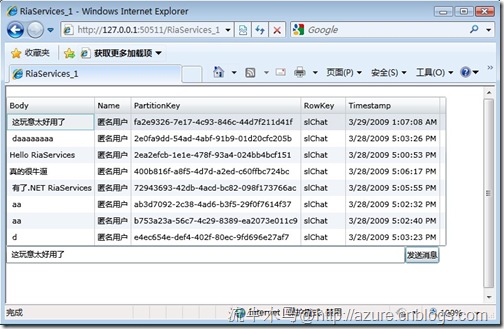
怎樣?非常方便吧?其實這只是一個非常簡易的實例而已, .NET RIA Services還包括了許許多多強大的功能,包括metadata,shared code等等等等,請感興趣的讀者自行閱讀SDK吧,那是一件非常享受的事情。